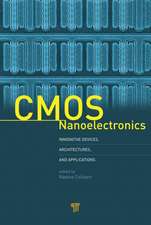Towards a Design Flow for Reversible Logic
Autor Robert Wille, Rolf Drechsleren Limba Engleză Paperback – 18 oct 2014
| Toate formatele și edițiile | Preț | Express |
|---|---|---|
| Paperback (1) | 552.45 lei 38-44 zile | |
| SPRINGER NETHERLANDS – 18 oct 2014 | 552.45 lei 38-44 zile | |
| Hardback (1) | 641.85 lei 6-8 săpt. | |
| SPRINGER NETHERLANDS – 18 aug 2010 | 641.85 lei 6-8 săpt. |
Preț: 552.45 lei
Preț vechi: 690.55 lei
-20% Nou
Puncte Express: 829
Preț estimativ în valută:
105.74€ • 114.90$ • 88.88£
105.74€ • 114.90$ • 88.88£
Carte tipărită la comandă
Livrare economică 17-23 aprilie
Preluare comenzi: 021 569.72.76
Specificații
ISBN-13: 9789400794252
ISBN-10: 9400794258
Pagini: 200
Ilustrații: XIII, 184 p.
Dimensiuni: 155 x 235 x 11 mm
Greutate: 0.29 kg
Ediția:2010
Editura: SPRINGER NETHERLANDS
Colecția Springer
Locul publicării:Dordrecht, Netherlands
ISBN-10: 9400794258
Pagini: 200
Ilustrații: XIII, 184 p.
Dimensiuni: 155 x 235 x 11 mm
Greutate: 0.29 kg
Ediția:2010
Editura: SPRINGER NETHERLANDS
Colecția Springer
Locul publicării:Dordrecht, Netherlands
Public țintă
ResearchCuprins
Preliminaries.- Synthesis of Reversible Logic.- Exact Synthesis of Reversible Logic.- Embedding of Irreversible Functions.- Optimization.- Formal Verification and Debugging.- Summary and Conclusions.
Recenzii
From the reviews:
“This is a book about the present and the future of computing machines. … At the end of the book a list of 144 refs are included giving the reader the possibility to know more than there are in the book. … the book represents an excellent text at a post-graduate level aiming to give to the researchers the basic ideas and techniques in this new emerging domain.” (Dumitru Stanomir, Zentralblatt MATH, Vol. 1210, 2011)
“This is a book about the present and the future of computing machines. … At the end of the book a list of 144 refs are included giving the reader the possibility to know more than there are in the book. … the book represents an excellent text at a post-graduate level aiming to give to the researchers the basic ideas and techniques in this new emerging domain.” (Dumitru Stanomir, Zentralblatt MATH, Vol. 1210, 2011)
Textul de pe ultima copertă
The development of computing machines found great success in the last decades. But the ongoing miniaturization of integrated circuits will reach its limits in the near future. Shrinking transistor sizes and power dissipation are the major barriers in the development of smaller and more powerful circuits.
Reversible logic provides an alternative that may overcome many of these problems in the future. For low-power design, reversible logic offers significant advantages since zero power dissipation will only be possible if computation is reversible. Furthermore, quantum computation profits from enhancements in this area, because every quantum circuit is inherently reversible and thus requires reversible descriptions. However, since reversible logic is subject to certain restrictions (e.g. fanout and feedback are not directly allowed), the design of reversible circuits significantly differs from the design of traditional circuits. Nearly all steps in the design flow (like synthesis, verification, or debugging) must be redeveloped so that they become applicable to reversible circuits as well. But research in reversible logic is still at the beginning. No continuous design flow exists so far.
In Towards a Design Flow for Reversible Logic, contributions to a design flow for reversible logic are presented. This includes advanced methods for synthesis, optimization, verification, and debugging. Formal methods like Boolean satisfiability and decision diagrams are thereby exploited. By combining the techniques proposed in the book, it is possible to synthesize reversible circuits representing large functions. Optimization approaches ensure that the resulting circuits are of small cost. Finally, a method for equivalence checking and automatic debugging allows to verify the obtained results and helps to accelerate the search for bugs in case of errors in the design. Combining the respective approaches, a first design flow for reversible circuits of significant size results.
Reversible logic provides an alternative that may overcome many of these problems in the future. For low-power design, reversible logic offers significant advantages since zero power dissipation will only be possible if computation is reversible. Furthermore, quantum computation profits from enhancements in this area, because every quantum circuit is inherently reversible and thus requires reversible descriptions. However, since reversible logic is subject to certain restrictions (e.g. fanout and feedback are not directly allowed), the design of reversible circuits significantly differs from the design of traditional circuits. Nearly all steps in the design flow (like synthesis, verification, or debugging) must be redeveloped so that they become applicable to reversible circuits as well. But research in reversible logic is still at the beginning. No continuous design flow exists so far.
In Towards a Design Flow for Reversible Logic, contributions to a design flow for reversible logic are presented. This includes advanced methods for synthesis, optimization, verification, and debugging. Formal methods like Boolean satisfiability and decision diagrams are thereby exploited. By combining the techniques proposed in the book, it is possible to synthesize reversible circuits representing large functions. Optimization approaches ensure that the resulting circuits are of small cost. Finally, a method for equivalence checking and automatic debugging allows to verify the obtained results and helps to accelerate the search for bugs in case of errors in the design. Combining the respective approaches, a first design flow for reversible circuits of significant size results.
Caracteristici
Currently, no other book considers several design steps of reversible circuits within an integrated flow Proposes several techniques for synthesis of very large functions in reversible logic So far, synthesis was only possible for small functions Questions like debugging of reversible logic have been considered for the first time Reversible logic is an emerging area. Once this kind of technology advances from the academic level to the industrial level, these approaches are required Includes supplementary material: sn.pub/extras















